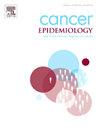Healthy lifestyle and the risk of endometrial cancer
IF 2.4
3区 医学
Q3 ONCOLOGY
引用次数: 0
Abstract
Background
The incidence and mortality rate of endometrial cancer (EC) is increasing worldwide. Modifiable lifestyle factors associated with an increased or decreased risk of cancer typically cluster. Therefore, this study aimed to investigate the association between a healthy lifestyle, measured with a Healthy Lifestyle Index (HLI), based on diet, smoking, alcohol consumption, physical activity and Body Mass Index (BMI), and the risk of EC.
Methods
A case-cohort analysis was conducted using data from the prospective Netherlands Cohort Study on Diet and Cancer (n = 62,573). At baseline in 1986, participants (aged 55–69) completed a questionnaire on potential cancer determinants. Data on aforementioned risk factors were used to calculate an HLI-score, ranging 0–20, with higher scores reflecting a healthier lifestyle. Cox regression analyses were used to estimate hazard ratios (HR’s) and 95 % confidence intervals (CI’s) for the association between HLI-score and EC risk in 414 cases and 1593 subcohort women, after 20.3 years of follow-up. After stratification by smoking status, Cox regression was applied using an HLI-score without smoking.
Results
The HR for the total HLI score was 0.86 (95 %CI 0.78–0.94) per 1 standard deviation (SD) increment. The HR for the HLI score without smoking component was 0.75 (95 %CI 0.67–0.83) for non-smokers (never smoked or former smoker >10 years ago) and 0.85 (95 %CI 0.70–1.02) for recent smokers (current or former smoker <10 years ago), all per 1 SD increment. Sensitivity analyses excluding each HLI component show that BMI and physical activity are the main drivers of the inverse association between HLI-score and EC.
Conclusion
A healthier lifestyle, measured with an HLI based on diet, alcohol consumption, physical activity, BMI and smoking is associated with a reduced EC risk. The association is stronger for non-smokers.
健康的生活方式和子宫内膜癌的风险
背景子宫内膜癌(EC)的发病率和死亡率在世界范围内呈上升趋势。与癌症风险增加或减少相关的可改变的生活方式因素通常集中在一起。因此,本研究旨在调查健康生活方式(以健康生活方式指数(HLI)衡量,基于饮食、吸烟、饮酒、体育活动和体重指数(BMI))与EC风险之间的关系。方法采用前瞻性荷兰饮食与癌症队列研究(n = 62,573)的数据进行病例队列分析。在1986年的基线上,参与者(55-69岁)完成了一份关于潜在癌症决定因素的问卷。上述风险因素的数据被用来计算hli得分,范围从0到20,得分越高,生活方式越健康。在20.3年的随访后,使用Cox回归分析来估计414例患者和1593名亚队列女性的hli评分与EC风险之间的风险比(HR’s)和95% %置信区间(CI’s)。按吸烟状况分层后,采用不吸烟的hli评分进行Cox回归。结果HLI总分的HR为0.86(95 %CI 0.78 ~ 0.94) / 1个标准差(SD)增量。非吸烟者(10年前从未吸烟或曾经吸烟)的无吸烟成分HLI评分的HR为0.75(95 %CI 0.67-0.83),最近吸烟者(10年前现在或曾经吸烟)的HR为0.85(95 %CI 0.70-1.02),均为1 SD增量。排除每个HLI成分的敏感性分析表明,BMI和身体活动是HLI评分与EC负相关的主要驱动因素。结论:健康的生活方式,以基于饮食、饮酒、体力活动、BMI和吸烟的HLI来衡量,与降低EC风险相关。对于不吸烟的人来说,这种关联更强。
本文章由计算机程序翻译,如有差异,请以英文原文为准。
求助全文
约1分钟内获得全文
求助全文
来源期刊

Cancer Epidemiology
医学-肿瘤学
CiteScore
4.50
自引率
3.80%
发文量
200
审稿时长
39 days
期刊介绍:
Cancer Epidemiology is dedicated to increasing understanding about cancer causes, prevention and control. The scope of the journal embraces all aspects of cancer epidemiology including:
• Descriptive epidemiology
• Studies of risk factors for disease initiation, development and prognosis
• Screening and early detection
• Prevention and control
• Methodological issues
The journal publishes original research articles (full length and short reports), systematic reviews and meta-analyses, editorials, commentaries and letters to the editor commenting on previously published research.
 求助内容:
求助内容: 应助结果提醒方式:
应助结果提醒方式:


